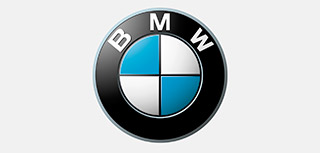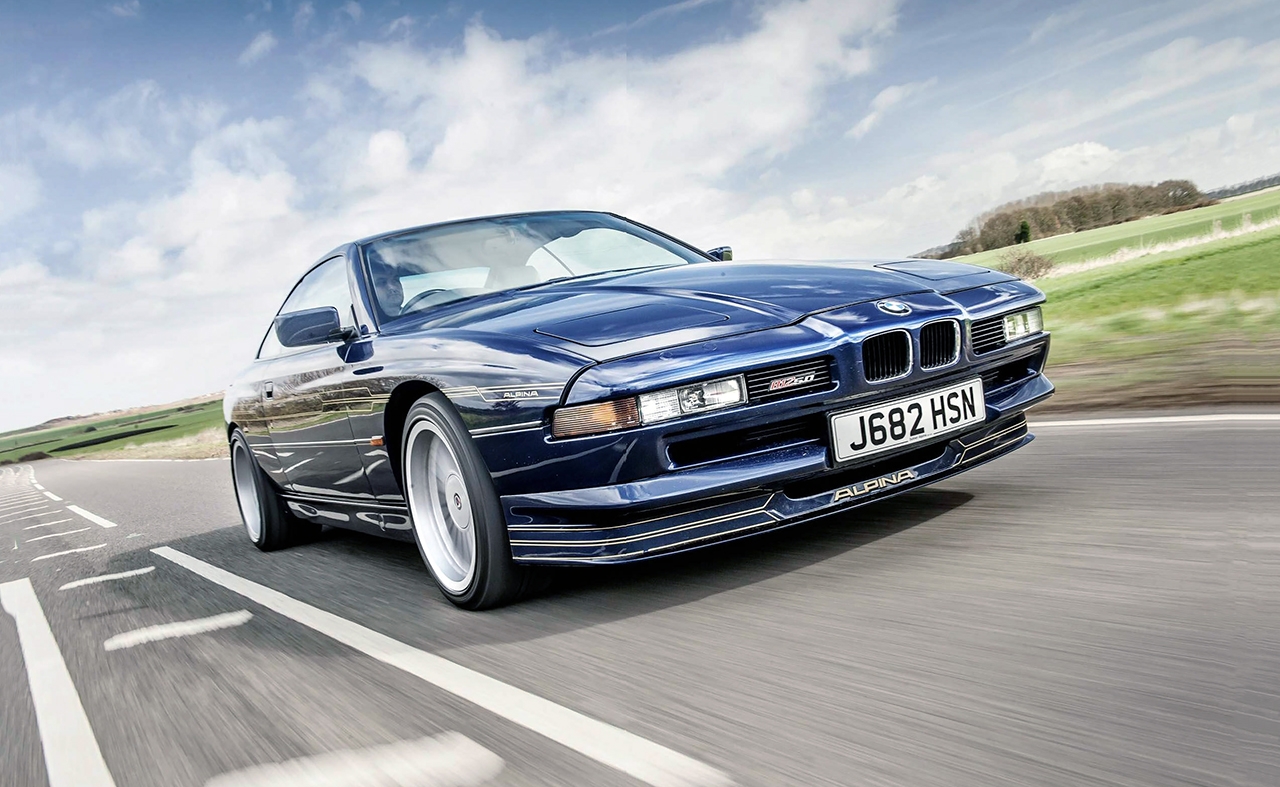
Alpina BMW 850i E31 smooth cruiser turned B-road blaster. We drive the BMW 850Ci Alpina transformed from soft-edged cruiser to hard-ball sports car. Alpina B12 5.0 Coupé Sam Dawson floors it in the BMW 850i Alpina E31 transformed from lacklustre boulevardier to eye-widening sports car – and meets the man who built them. Alpina faced a colossal challenge in turning the notoriously numb BMW 850i into a driver’s car worthy of the marque. A blast around its Nottinghamshire homeland reveals if it succeeded. Undercover Supercar Alpina B12 5.0 Coupé E31 8-Series. Words Sam Dawson. Photography Laurens Parsons.
Where’s that noise coming from? Amid an antiseptically clean showroom full of new BMWs parked with millimetric precision and tended to by showroom staff with the manners and efficiency of butlers, something strident and Italianate shrieks into life, its fast-idle cycle booming incessantly like a roadie tuning a bass drum. In a world full of whispering turbodiesels and meek stop-start ignition systems, the normally aspirated 12-cylinder flamboyance of a gold-striped Alpina B12 Coupé is alien.
It appears at first glance to be a BMW 850i. NSU Ro80 designer Claus Luthe’s 1989 E31 8 Series shape was always dramatic, its needle-snout and vast pop-up headlight slabs reminiscent of Giugiaro’s M1. However, early corporate pride in its 0.29 drag coefficient and near-300bhp V12 was dampened considerably once the press got their hands on it.
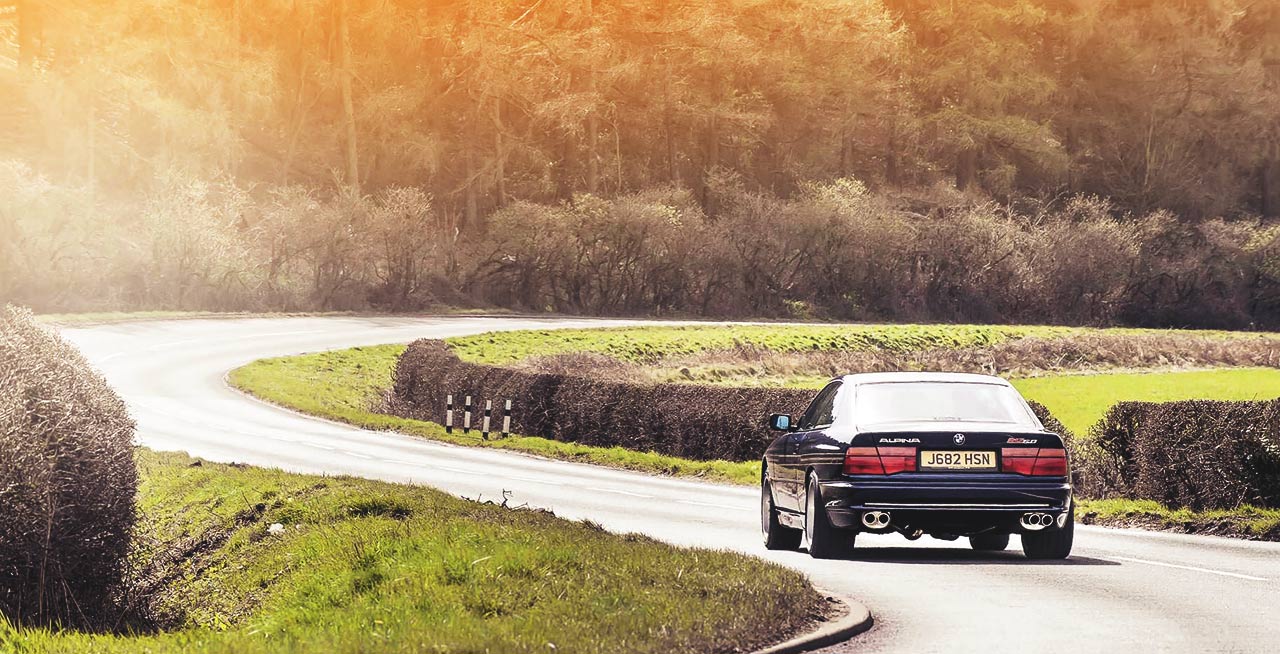
B12’s meaty and responsive hydraulic steering is a vast improvement on original 8 Series’ numb Servotronic system.
It may have had a M70 V12 but it was more of a Jaguar-esque hissingturbine than some howling monster from BMW’s M Sport department. Its Servotronic electric power steering system endowed the helm with all the feel of a pair of gardening gloves and while its new camber-controlling Z-axle rear suspension may have tamed BMW’s Eighties reputation for mid-corner hedge-demolition by maximising grip, the way it seemed to carve high-speed arcs through bends without so much as a twitch took away all the fun. In short, the 850i was seen as a £62,000 monument to over-engineering and proof that genuine ‘ultimate driving machines’ come via Nomex racesuits, not white laboratory coats.
Pulling out of the showroom and on to the A52 with the electronically adjustable dampers in their ‘Komfort’ setting, my immediate impression is that not enough has been done to overhaul the base car. The soft rear suspension lopes noticeably, creating a feeling of imprecision as the big coupé ambles over road surface imperfections. It feels not unlike a Jaguar XJ-S and makes me wonder if it’s quite as well-suited to autobahn conditions as its reputation would suggest. Maybe time has simply been unkind to it.
There’s a clue to Alpina’s handiwork in the weight of the steering. The Alpina-branded wheel has a smaller diameter than the standard car’s battleship helm and feels as tactile as a small Alfa Romeo’s, jiggling excitedly over every ripple and camber change in the road. The reason for this is down to Frank Sytner, Nottingham Alpina agent, licenced constructor and two-time British Touring Car Championship winner – for it was he who suggested ditching the entire Servotronic system in favour of a conventional hydraulic set-up. Down by the gearlever are two innocuous-looking rocker switches. Flick them both to S for Sport and the Alpina’s character changes instantly. There’s a slight twitch from the helm even when crawling at 20mph as the dampers firm up. The shuddering impression disappears and is replaced by something that feels rather like the taut haunches of a guard dog that’s just sensed an intruder.
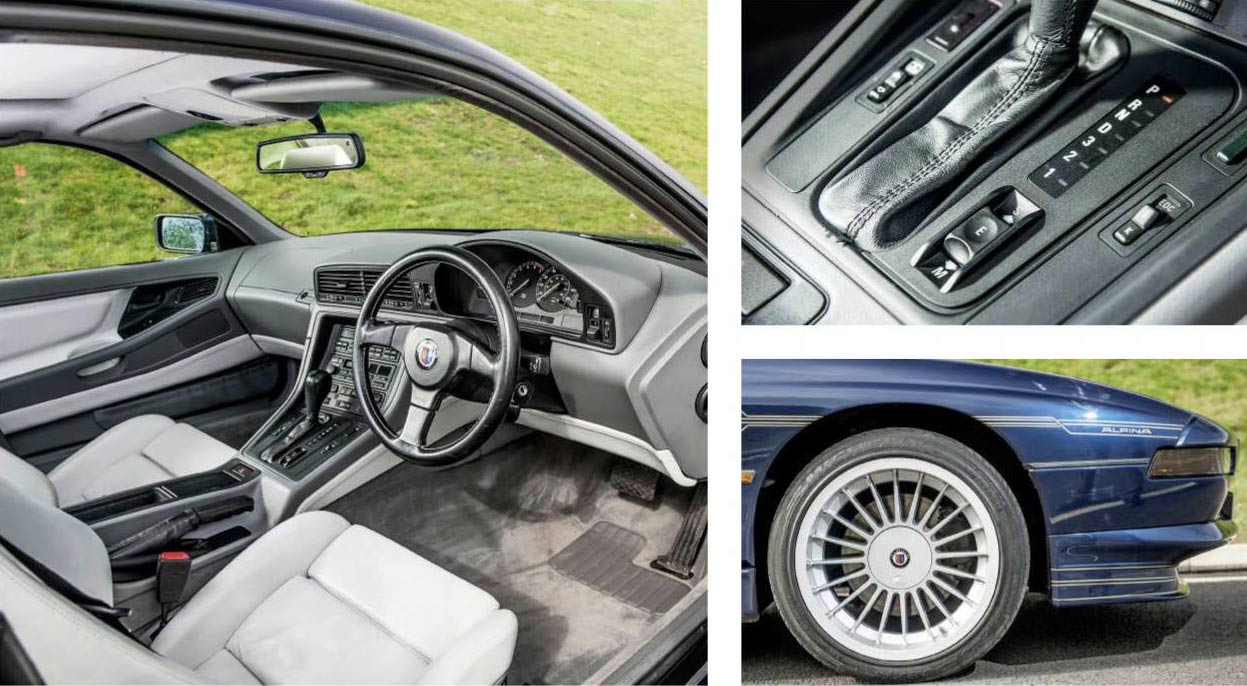
Turbine-style wheels and none-too-subtle pinstriping have set Alpinas apart from the mundane for decades. Bespoke quality leather and new steering wheel lift interior, but dials are disappointingly ordinary for an Alpina. All-important Sport buttons transform the B12 from boulevardier to out-and- out sports car.
The bespoke Alpina ECU’s throttle map changes from the softresponse, wet-road-friendly M setting to a sharper and harsherrevving profile. Changes on the four-speed automatic gearbox are so seamless that it feels like a continuously variable set-up but in Sport mode it’ll rocket from 2000rpm to 4500rpm in second gear without hesitation. It’s assertive rather than aggressive acceleration, with no sudden skittishness or driveline shunt no matter how hard you hit the pedal. The deep, resonant rumble from the exhausts builds to an exotic, full-bodied howl but it’s Bayreuth tenor belting through a robust tract of Wagner rather than an Italian soprano mastering intricate Rossini high notes.
Huge tyres – 245/40 ZR18s at the front, 285/35 ZR18s at the rear – and damping that remains progressive even when firmed-up by electronic servos mean the big coupé flows with the undulating A60. Occasional spatters of mud left by tractors cause the traction control light to flicker and remind me that there’s 350bhp coursing through the rear wheels, but it never feels as though the power is being reined in. The car feels narrow by modern standards, a sense aided by pencil-thin roof pillars, a low window line and expansive, curving rear screen. In fact it puts me in mind of a nimble E36 M3 rather than something getting on for the size of a 7 Series.
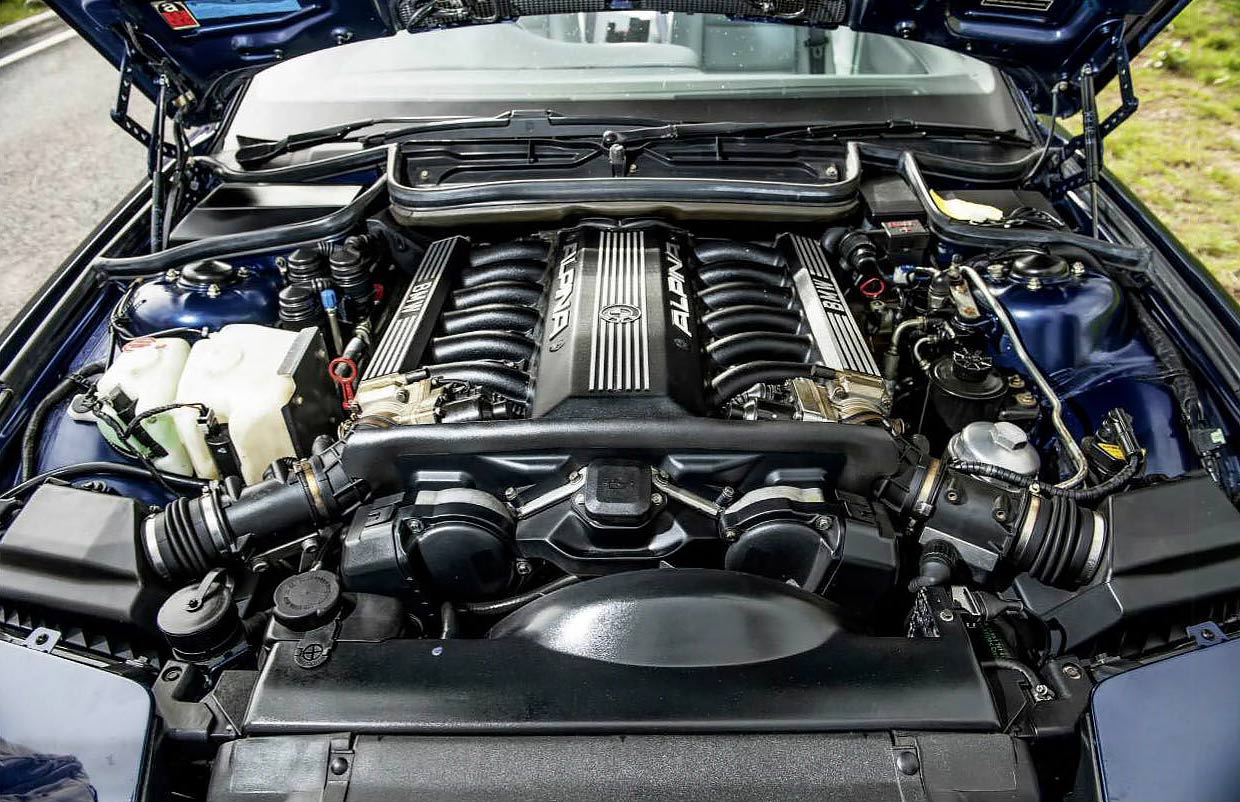
Alpina forged camshafts, new exhaust and bespoke ECU lift blueprinted V12’s power and low-down responsiveness.
That engine, with its Alpina forged camshafts and bespoke exhaust system, is instrumental to the car’s appeal. The V12 manages to combine the aural satisfaction of something brittle and Italian with the reassurance of German build quality, yet manages to avoid the rev-dependent characteristics of some V12s whose throttles often seem unresponsive at low speeds as a result. Peak torque – 347lb ft – arrives at a relatively high 4000rpm but the free-spinning nature of the engine means it’s easy to get there and lends the Alpina the responsive point-and-punch usability of an American V8.
But it’s the steering that truly transforms this car. Any competent aftermarket tuning firm can make an engine more responsive – within reason – but it takes a manufacturer like Alpina and a racing driver of Frank Sytner’s calibre and boldness to replace a thoroughly engineered and mass-produced steering system in the name of improved tactility. Its weight and slight nervousness lends the car a slightly old-fashioned air. This, combined with the exotic, torqueladen engine and well-balanced handling actually puts me in mind of a modernised Maserati Indy or Ferrari 400i rather than a Nineties supercruiser.
Having found a quiet country road I flick both Sport switches and the B12 doesn’t protest when I treat it like a sports car. It combines the sense of excitement you feel behind the wheel of a Ferrari 550 Maranello – all booming V12 and bottomless power reserves – with the roadholding security you’d expect from an idiotproof automatic luxobarge. I find myself driving it like a kart within a few bends, my left foot hovering over the brake pedal ready to deliver a quick tap to slow it a little ahead of the next corner. You can feel the lateral G-forces surging through the cabin but it never loses its luxurious composure. The ride is taut but never harsh – likely a side-effect of the car’s near 1.8-ton weight. The V12 song is everpresent – not contrivedly strident and noisy as it is in many modern super-GTs but tuned into aural acceptability by the bespoke exhaust.
All of this is welcome in the context of the 850i. In its keenness to try out new – and predominantly electronic – ideas, BMW was too scientific in its development of the E31 and lost sight of driver involvement as a result. There’s no doubting the honed quality of BMW’s ingredients – it’s just that it forgot to cook them properly. The Alpina B12 5.0 coupé demonstrates how close the standard 8 Series could have come to greatness had it been developed by a different team. As an Alpina, it feels more like an Aston Martin V8 coupé rival, right down to its handbuilt cockpit with the off-the-peg donor’s slightly plasticky ruched leather seats and door inlays replaced with hand-finished hides and cloths. The standard instrument binnacle brings the ambience down to earth slightly – but bear in mind that Astons of this era were using chunks of Ford and Vauxhall in their cabins.
There’s virtue in its semi-undercover looks too. As the road deteriorates into roadworks, contraflows and sluggish traffic, other motorists’ eyes slide over the B12 without a second glance. To most it’s just an old BMW. A select few however slow down when they spot the gold pinstripes and chunky red boot-badges and respond with nods of recognition. Tellingly, each has something in common – one is driving a Honda Integra Type-R, another a rarer-still Mitsubishi Legnum VR-4. E31s are uncommon enough as it is, but this one’s visual cues are clearly known only to the cognoscenti. This makes a welcome change from the sometimes embarrassing feeling that comes with driving a Ferrari, Lamborghini – or even an Aston Martin – when everyone points, takes photos and passes comment. The fact that the B12 is as competent a driving tool – and as bespoke an ownership prospect – as any better-known exotic opposition somehow adds to its appeal.
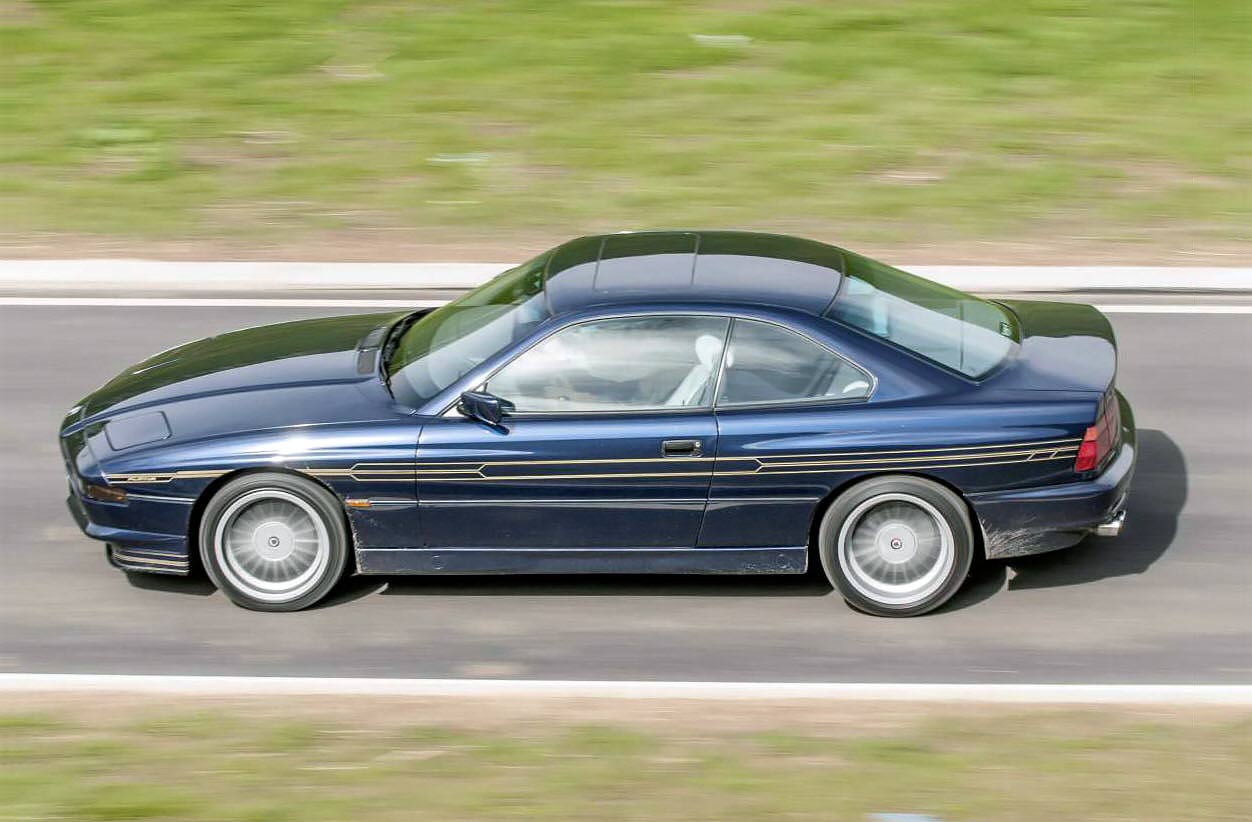
1991 BMW 850Ci Alpina B12 5.0 Coupé E31 8-series road test
I’m reluctant to return it to the dealer because it’s not often you encounter such an uncanny all-rounder. I’ve subjected it to busy motorways, wet A-roads, muck-strewn unclassified country trails and the urban crawl and not once has it felt out of its depth. The flourishes of leather and velour give it the ambience of something bespoke yet it’s backed up with the solidity of a production-line BMW. The engine is soulful and rich in character, yet I wouldn’t worry about it drifting off tune or disintegrating parts on a week-long continental thrash.
Best of all, though, it still looks like an 8 Series. Basing something extraordinary on a mass-produced car can often backfire because it disguises the magic in tedious anonymity. However, in this case, Claus Luthe’s 8 Series always looked like a supercar – it just took Alpina to make it drive like one.
TECHNICAL DATA 1991 ALPINA B12 5.0 COUPÉ
Engine 4988cc, V12, sohc per bank, Bosch Motronic M1.7 fuel injection
Power and torque 350bhp @ 5300rpm; 347lb ft @ 4000rpm
Transmission Four-speed automatic, rear-wheel drive
Steering Recirculating ball, hydraulic power-assistance
Suspension Front: MacPherson struts, lower links, coil springs, telescopic dampers, anti-roll bar. Rear: Z-axle, five control arms, coil springs, telescopic dampers, anti-roll bar
Brakes Servo-assisted discs front and rear
Weight 1790kg (3946lb)
Performance Top speed: 174mph; 0-60mph: 6.8sec
Fuel consumption 15mpg
Cost new £87,000
Values now £37,000-£60,000
‘I BUILT THEM’
In 1988, Frank Sytner sent Mark Adkin to Buchloe to learn how to create an Alpina – and bring those skills back to the UK.
‘TWR did the conversions early on,’ recalls Alpina engineer Mark Adkin of Burkard Bovensiepen’s early forays into British production outsourcing in the Seventies, ‘but with Tom Walkinshaw being Tom Walkinshaw he’d do his own thing. Alpina would stipulate a specially tuned 3.5-litre straight-six engine to go into 3 Series and Walkinshaw would just transplant an engine from a stock 7 Series instead. In truth he was taking things in the wrong direction.
‘Frank Sytner was the right kind of person to take charge. He knew Burkard Bovensiepen through racing BMWs for many years. Bovensiepen wanted to become an officially recognised manufacturer from 1983. Sytner agreed to start offering Alpina parts and conversions from 1982 and said he could build them in Nottingham from 1985.

Adkin’s Alpina training was a challenge. ‘It was difficult because only one instructor spoke English’. Period Alpina ‘passport’ proves Mark’s official training.
‘After receiving my basic BMW training at the main dealer in Reading, I was sent out to Germany in November 1988 for a three-day course. It was difficult because only one of the instructors – Kurt Voss – spoke English.
‘I was back the following November for the B12 conversions. Alpina wanted to turn the B12 into a coherent V12 model range with saloon and coupé variants based on the E32 750i and E31 850i. This was to cement its status as a manufacturer rather than an aftermarket tuner, which has always been Bovensiepen’s intention. However, tooling up for bodywork production would be so expensive as to make the whole operation unviable.
‘BMW sent the production-line cars over to Buchloe and Nottingham in a half-built state. They had steel wheels, no engine or gearbox and plastic blanking plates all over the cabin where the hand-finished trim would eventually go; the exact specification was always directed by the customer.
‘To my mind, the B12 is the ultimate Alpina. It was a 350bhp V12 at a time when BMW’s production car offered only 300bhp and Alpina built just 35 of them. It cost £25,000 more than the standard car but offered complete exclusivity – even more so than the equivalent Aston Martin. They are very much handbuilt cars too – the trademark orange dial markings on some of the early examples were applied by hand using paint from a Humbrol model fire engine kit!
‘The greatest Alpinas we’ve built here were probably the Sultan of Brunei’s B12 5.7 coupés. All the standard coupés were made in Buchloe but the Sultan wanted his cars to be right-hand drive to suit the roads in Brunei, so they were based on UK-market cars. He has the only two right-hand-drive Ferrari F40s in existence for the same reason.
‘On the 5.0-litre B12s, Alpina supplied a blueprinted engine with new camshafts and exhausts, and all five ECU units had to be removed and replaced. We had to refit the sill in order to fit the Alpina kickplates under the doors too.
‘We worked extensively with Michelin in order to get the grip and damping right. It was at this stage that Frank Sytner decided to ditch the Servotronic steering system in favour of a more feel-some hydraulic set-up. We built five prototypes – three with Servotronic steering and two with hydraulic – and Sytner felt that it was easier to judge the limits of the new wider tyres with the older-style set-up.
‘As far as exotic cars go, they’re reliable. There’s a B12 up in Scotland that’s still driven daily by its first owner. It’s got 114,000 miles on the clock and so long as it’s maintained properly it should go on for ever. Frank Sytner still drives Alpinas as everyday road cars too.’
‘The Alpina B12 5.0 coupé’s exotic, torque-laden engine and well-balanced handling are reminiscent of a modernised Maserati Indy or Ferrari 400i’
‘The V12 combines the aural satisfaction of something brittle and Italian with the reassurance of German build quality’
{module bmw 8 e31}

